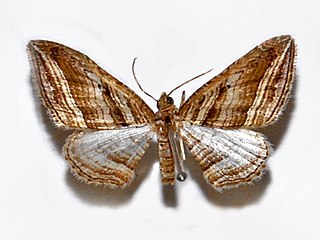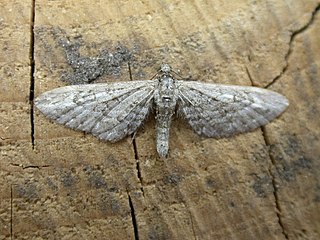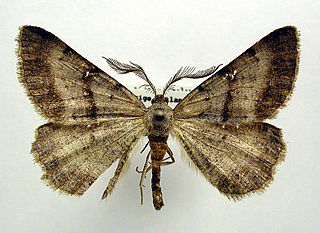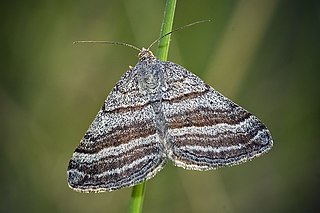
The slender pug is a moth of the family Geometridae. It was first described by Jacob Hübner in 1813 and is found throughout Europe and western parts of the Palearctic. The larva feeds on the catkins of willow.

The double-striped pug is a moth of the family Geometridae. It is a widespread and common species, being found throughout the Palearctic region, including the Near East and North Africa.

The scalloped oak is a moth of the family Geometridae. The species was first described by Carl Linnaeus in his 1758 10th edition of Systema Naturae.

Scotopteryx is a genus of moths of the family Geometridae described by Jacob Hübner in 1825. It is suspected that some species currently placed here actually belong in Entephria.

Scotopteryx chenopodiata, the shaded broad-bar, is a moth of the family Geometridae. It was first described by Carl Linnaeus in his 1758 10th edition of Systema Naturae.

Anania stachydalis is a species of moth of the family Crambidae. It is found in Europe. The species closely resembles Anania coronata.

Euxoa obelisca, the square-spot dart, is a moth of the family Noctuidae. It is found in the Palearctic realm.

Eupithecia nanata, the narrow-winged pug, is a moth of the family Geometridae. The species was first described by Jacob Hübner in 1813. It can be found all over Europe including Russia and Ukraine. In the Alps it occurs up to 2,200 metres (7,200 ft) above sea level and in the Pyrenees to 2400 meters. The species prefers dry or boggy heathlands.

Cyclophora puppillaria, or Blair's mocha, is a moth of the family Geometridae. The species was first described by Jacob Hübner in 1799. It can be found in Europe and from North Africa up to the Caucasus area.

Nola aerugula, the scarce black arches, is a moth of the family Nolidae. The species was first described by Jacob Hübner in 1793.

Euphyia biangulata, the cloaked carpet, is a moth of the family Geometridae. It is found in most of Europe and the Middle East.

Euphyia unangulata, the sharp-angled carpet, is a moth of the family Geometridae. It shares its common name with the similarly coloured Neoarctic, Euphyia intermediata.

Selidosema brunnearia, the bordered grey, is a moth of the family Geometridae. The species was first described by Charles Joseph Devillers in 1789. It is found in central and southern Europe, Asia Minor, Transcaucasia and North Africa.

Furcula occidentalis, the western furcula moth, double-lined furcula or willow kitten , is a moth of the family Notodontidae. It is found from southern Yukon and British Columbia to Nova Scotia, south to Maryland and west to Utah and Oregon.

Scotopteryx coarctaria is a species of moth in the family Geometridae. It is found in most of Europe, except Ireland, Great Britain, Portugal, Belgium, Fennoscandia and the Baltic region. It has also been recorded from Turkey and Kazakhstan.

Scotopteryx mucronata, the lead belle, is a species of moth in the family Geometridae. It is found in most of Europe, Turkey, Ukraine, West Siberia.

Chesias rufata, the broom-tip, is a moth of the family Geometridae. It was described by Johan Christian Fabricius in 1775. It has a wide range in central and western Europe, including Great Britain and Ireland. It is also found from Morocco to Asia Minor.The species prefers heaths, bushy slopes and rocky valleys which favour its foodplants.It is found up to 1,500m in the Alps.

Chionodes distinctella, the eastern groundling, is a moth of the family Gelechiidae. It is found in almost all of Europe, as well as most of Russia, Kazakhstan, Central Asia and North Africa. The habitat consists of dry, rocky heath and meadows and the verges and rough pastures.

Scotopteryx kurmanjiana is a species of moth of the family Geometridae first described by Hossein Rajaei and Gyula M. László in 2014. It is found on both sides of Kopet-Dagh Mountains in north-eastern Iran and southern Turkmenistan.

Uresiphita reversalis, the genista broom moth or sophora worm, is a moth in the family Crambidae. It was described by Achille Guenée in 1854. U. reversalis was probably native to Mexico before spreading north and becoming established in Los Angeles by 1930 and the San Francisco Bay Area by 1980. It has since been recorded across the United States and in Cuba, Bermuda, Puerto Rico and Jamaica. Both adults and caterpillars are aposematic.






















